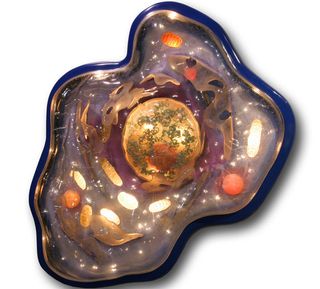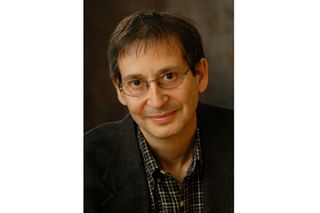How Ancient Life May Have Come About

A family tree unites a diverse group of individuals that all carry genetic vestiges from a single common ancestor at the base of the tree. But this organizational structure falls apart if genetic information is a communal resource as opposed to a family possession.
Some evidence suggests that early evolution may have been based on a collective sharing of genes. A group of researchers are now searching for clear genetic vestiges from this communal ancestry.
But it's hard to shake our fascination with family trees.
My father used to travel for work, and when he arrived in a new city, he'd open up the phone book and check for anyone listed with our uncommon last name. Occasionally he'd get a hit and brazenly call them up to ask: "Are we related?"
The answer was always yes, with the common link often being my great grandfather.
Like my father, biologists are curious about family ties, but they go about it in a more systematic way. Rather than phone books, they sift through genetic codes from humans to bacteria and a lot in between. The main question is: Are the commonly held genes similar enough to point to a common origin?
The answer has always been yes. The implication is that we all belong to some universal tree of life. And at the base of this tree — some have imagined — there sits a mild-mannered microbe that lived more than 3 billion years ago, unaware that its genes would be the starting point of an entire planet's worth of highly differentiated life.
Sign up for the Live Science daily newsletter now
Get the world’s most fascinating discoveries delivered straight to your inbox.
However, this organism, the so-called last universal common ancestor (or LUCA), may be just a fantasy.

"Our perspective is that life emerged from a collective state, and so it is not at all obvious that there is one single organism which was ancestral," said Nigel Goldenfeld from the University of Illinois at Urbana-Champaign.
The organisms belonging to this collective state would have shared genetic information from neighbor to neighbor, rather than solely from parent to offspring. Goldenfeld is leading a new NASA Astrobiology Institute (NAI) team that aims to provide a clearer understanding of this early stage of evolution.
"We are hoping to find fossils of the collective state in the genomes of organisms," Goldenfeld said.
Goldenfeld's team will be performing genetic studies that will try to tease out signatures of community-based evolution. They will complement this field and laboratory work with theoretical modeling and computer simulations.
"The ultimate goal is to understand how our planet's biochemistry is an instantiation of the universal laws of life, thus addressing the question of whether life is an inevitable and thus widespread outcome of the laws of physics," Goldenfeld said.
A time before Darwinism
It might sound strange that an organism's genetic code could be the result of "crowdsourcing." We are more familiar with traditional reproduction, as practiced by the birds and the bees. [Code of Life: 10 Animal Genomes Deciphered]
In so-called "vertical gene transfer," an organism inherits its genome from its parents, but it does not receive an exact copy. Small changes enter the code through reproductive mixing and mutations. This "descent with modification," as Darwin put it, eventually allows a population of interbreeding organisms (or species) to evolve.
If every snippet of DNA was solely the product of descent with modification, then every organism could be placed on a tree of life stemming from a single ancestor. But as it turns out, "different genes go back to different ancestors," said Peter Gogarten of the University of Connecticut, who has done extensive work on comparative genetics.
How is that possible? It can happen if organisms share genes. Imagine a gene belonging to members of a specific family tree. One day, this gene becomes isolated and gets picked up by another organism with a different family tree. No reproduction between partners takes place — only an "adoption" of a specific gene.
This so-called "horizontal gene transfer" is quite common among bacteria and archaea, as exemplified by antibiotic resistance. When a specific bacterium develops a defense against some drug, the corresponding gene can pass horizontally to others in the same colony.
A 2008 study in the journal Proceedings of the National Academy of Sciences (PNAS) found that 80 percent of the genes in bacteria were horizontally transferred at some point in the past.
Complex organisms also exhibit evidence of horizontal (or lateral) gene transfer, albeit to a lesser extent. Researchers have shown that ancient ancestors of plants and animals "swallowed up" other bacteria to form symbiotic relationships, which eventually resulted in specialized cellular components, such as mitochondria and chloroplasts.
In his work, Gogarten has shown that horizontal gene transfer turns the tree of life into a thick bush of branches that interweave with each other. Many of these branches terminated long ago due to extinction, but some of their genes live on in us, thanks to horizontal gene transfer.
Several studies suggest that horizontal gene transfer was more prevalent in the past when nothing but single-celled organisms inhabited the Earth.
"I like to think of early life as being more like an undifferentiated slime mold," Goldenfeld said. "Such a communal form of life would have no meaningful family tree, because it is the community that varies in descent, not individual organismal lineages." [[7 Surprising Theories on the Origin of Life]

Evolving evolution
The late Carl Woese, a colleague of Goldenfeld, was one of the first scientists to propose that early life leaned heavily on horizontal gene transfer. Woese passed away in December of last year. He is perhaps best-remembered for classifying life into the now-well-accepted domains of bacteria, eukaryotes (plants, animals, fungi and protists) and archaea.
In 1987, Woese wrote about the consequences of rampant horizontal gene transfer. In such a scenario, "a bacterium would not actually have a history in its own right: It would be an evolutionary chimera."
A "chimera" is the name of a creature from Greek mythology that mixed together features of a lion, a goat and a snake. This hybridization presumably gave the chimera an advantage over its "competitors."
In a 2006 PNAS paper, Kalin Vetsigian, Woese and Goldenfeld showed that microbial chimeras may also have an advantage over their biological counterparts. The researchers used computer models to demonstrate that the genetic code could evolve more efficiently if organisms shared their genes collectively. Horizontal gene transfer turned out to be a better "innovation-sharing protocol" than vertical (Darwinian) transfer.
Now, with his NAI team, Goldenfeld wants to confirm these simulations with genetic studies. Specifically, they will target archaea, whose genes have yet to be scrutinized as closely as those from the other domains, Goldenfeld said.
The group is particularly interested in the question of how the ability to evolve originally developed. The "evolution of evolution" sounds like a chicken-and-egg problem — especially if you think, as Goldenfeld does, that life is by definition something capable of evolving.
However, evolution can utilize different mechanisms to achieve the same goal. Goldenfeld's team will try to recover some of life's former evolutionary phases by stressing cells and then seeing how their genomes rearrange in response.
Universal biology
However, DNA evidence is just one aspect of this five-year research project.
"We want to understand how evolution works before there were species or maybe even genes," Goldenfeld said. "So this is going beyond 'origin of species' approaches to evolution, such as population genetics."
How does one study evolution without genetics? One considers the "rules of the game" that the genetic code is just one manifestation of. Goldenfeld calls this "universal biology." It is an attempt to distill from our specific biochemistry the general physical laws that animate matter.
Being a physicist, Goldenfeld gives the example of thermodynamics. Life must obey conservation of energy and the law of increasing entropy, which will certainly influence how organisms optimize their use of resources.
Other rules involve how to control the amount of variation in the genome from one generation to the next. Too little variation, and organisms can't adapt to changes in the environment. Too much variation, and organisms can't retain useful traits.
The team can place different sets of rules into a computer simulation and see what sort of artificial life appears. Goldenfeld believes that formulating the principles of universal biology may help answer one of the biggest questions of all.
"We would like to have a better understanding of why life exists at all." Goldenfeld said. "Is it a phenomenon that should be generic, like the formation of a crystalline solid, or is it something rare and bizarre?"
This is of special interest to astrobiologists, who wonder about the likelihood that we are not alone. If life is eventually found elsewhere, Goldenfeld thinks we'll have a few things in common. [Mars Discovery Raises Question: What Is Life?]
"The principles of universal biology should be applicable to all life irrespective of whether it is carbon chemistry-based or something stranger," he said.
Something stranger? Okay, so maybe that means they won't be in the phone book.
This story was provided by Astrobiology Magazine, a web-based publication sponsored by the NASA astrobiology program.
Most Popular



